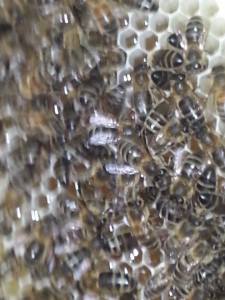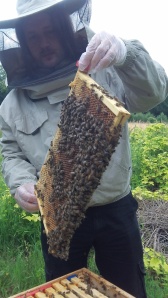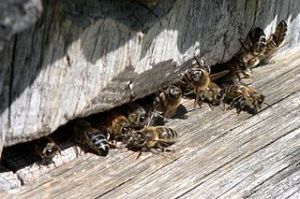So on Thursday we went to carry out our first solo inspection of the hives (and to replace the crown boards).
It was another beautiful, incredibly hot day, with the ground in the distance shimmering in the heat. We arrived at the site where the hives are kept (fortunately a nice shady area!), had a quick breather, and then got stuck in. First job was to replace the crown boards on two of the hives. The bees were a lot calmer now that they’ve had a chance to settle into their new home, however, as we seem to have misplaced our hive tool and our bees love their propolis, we weren’t able to pry many frames out to take a proper look. From what we could see however, everything in the healthy, Q+ hive looks good, and the Q- hive which had capped queen cells last week is brimming with (slightly grumpy) bees.
With a new hive tool on the way, we’re aiming to give all the hives a proper inspection this Sunday (Saturday has a very wet forecast, which would make for grumpy bees!). Most urgent is to check the status of the grumpy hive, to see whether or not there is a queen present, or if there are still queen cells. If there is a queen in residence, we’ll be adding a brood box as this hive is absolutely brimming with bees!

Worker bees busily drawing out the comb. You can see the glistening of honey in the cells if you look closely!
The final job for Sunday is to sort out the hive with the laying workers. The plan is to firstly take the entire hive and dump all of the bees out about 50-70 metres from the current site, the idea being that the flying bees (who are not laying) will fly back to the original hive, and the nurse bees (the laying workers) will be disorientated and will not return, as they have never left the hive before. Then, we’ll try inserting a frame of open brood, which will emit the pheromones which help to suppress the laying instinct in the worker bees, and from which they’ll hopefully try to raise their own queen. If we find any spare queen cells in the other hives, we’ll also be attaching one to the frame of brood in the hope that they may accept that as their new queen.
We’ve been told that there’s a high probability this may fail, but we feel it’s worth a try, as left to its own devices the colony would die out anyway, and at least this way we have a chance of saving it.

The worker bees on this frame are just starting to draw out the comb. Hopefully over the next few weeks they’ll fill this with honey!
Thank you for all the advice we’ve been given up to this point from all the experienced beekeepers we’ve spoken to, especially the people over at http://www.beekeepingforum.co.uk/.
Fingers crossed everything goes as planned on Sunday, although you never know with bees!






![Beekeepersmoker[1]](https://oldboarsapiary.files.wordpress.com/2014/06/beekeepersmoker1.jpg?w=269&h=300) ee rustling is a thing.
ee rustling is a thing.![Varroa_Mite[1]](https://oldboarsapiary.files.wordpress.com/2014/06/varroa_mite1.jpg?w=676)